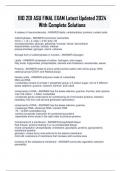BIO 201 ASU FINAL EXAM Latest Updated 2024
With Complete Solutions
4 classes of macromolecules - ANSWER-lipids, carbohydrates, proteins, nucleic acids
Carbohydrates - ANSWER-monomers: saccarides
mono = 1, di = 2, oligo = 3-50, poly= 50
monosaccharides: glucose, galactose, fructose, ribose, deoxyribose
disaccharides: sucrose, lactose, maltose
polysaccharides: glycogen, starch, cellulose
Storage form of carbohydrates in humans - ANSWER-Glycogen
Lipids - ANSWER-composed of carbon, hydrogen, and oxygen
fatty acids, triglycerides, phospholipids, steroids and cholesterol, eicosanoids, waxes
Proteins - ANSWER-made of amino acids (central carbon with amino group -NH2,
carboxyl group-COOH, and Radical group)
Nucleic acids - ANSWER-polymers made of nucleotides
DNA and RNA
-nucleotides consist of at least 1 phosphate group, a 5-carbon sugar, one of 5 different
bases (adenine, guanine, cytosine, thymine, and uracil)
components of DNA - ANSWER-has the bases adenine, guanine, thymine, and cytosine
-has 100 million - 1 billion nucleotides
-constitutes genes (instructions for synthesizing all of the body's proteins, transfers
hereditary info from cell-cell and generation-generation)
components of RNA - ANSWER-has the bases adenine, guanine,
-messenger RNA, ribosomal RNA< transfer RNA
-70 - 10,000 nucleotides long
-carries out genetic instruction for synthesizing proteins
-assembles amino acids in the right order to produce proteins
Components of a membrane - ANSWER-phospholipid bilayer
fluid mosaic: proteins floating in or on phospholipid bilayer
mixed composition: phospholipids, cholesterol, glycolipids, proteins, glycoproteins
membrane proteins
glycoalyx: unique fuzzy coat external to the plasma membrane
microvilli: extensions of membrane that increase cell's surface area
functions of the cell/plasma membrane - ANSWER-surrounds organelles, selective
permability
, organelles - ANSWER-nonmembranous: ribosomes, centrosomes, centrioles, basal
bodies
membranous: nucleus, endoplasmic reticulum, Golgi complexes (apparatus),
lysosomes, peroxisomes, and mitochondria
Ribosomes - ANSWER-site of protein synthesis
has proteins and ribosomal RNA
Centrosomes - ANSWER-holds centrioles
-role in cell division
Centrioles - ANSWER-short microtubules arranged in 9 groups of 3
-2 centrioles lie within a small, clear area of cytoplasm called the centrosome
Basal Bodies - ANSWER-
nucleus - ANSWER-control center for the entire cell, stores DNA
nuclear envelope, nucleolus, chromatin
endoplasmic reticulum - ANSWER-smooth and rough (has ribosomes)
SER: synthetic processes like lipid metabolism, cholesterol synthesis, and synthesis of
steroid hormones; detoxification of drugs and carcinogens, storage
Golgi complex - ANSWER-like UPS store: modifies, sorts, and ships protein-filled
vesicles from ER
lysosomes - ANSWER-breakdown all 4 macromolecules (the janitors) if organelles are
old and worn out or for autolysis "cell suicide"
peroxisomes - ANSWER-break down fatty acids and amino acids, neutralize dangerous
free radicals
Anatomical position - ANSWER-person stands erect w/ feet flat on floor and arms at
sides. Palms, eyes, and face forward
Directional terms - ANSWER-superior, inferior, medial, lateral, proximal, distal,
superficial, deep, anterior and posterior vs ventral and dorsal
Planes of the body - ANSWER-Sagittal (mid, para)
Frontal
Transverse
Sagittal plane - ANSWER-divides the body into right and left halves
Frontal (coronal) plane - ANSWER-divides the body into front and back portions




